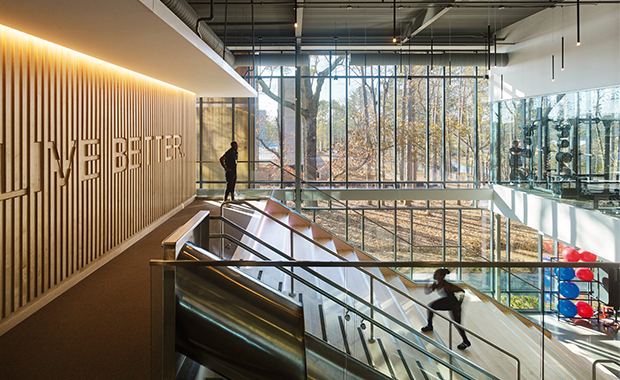
Juan Rovalo (Headshot Courtesy of Perkins&Will)
Healing is a holistic process that encompasses our physiological and mental well-being. A growing body of evidence suggests that direct experiences with green spaces, natural processes, and living organisms significantly support our overall health.
As research continues to uncover the exact mechanisms behind this correlation, we see opportunities to design environments that support human health and happiness through the careful integration of nature.
Human evolution and nature
For 99 percent of our evolutionary history, humans have relied on the precise interpretation of environmental information for survival. In his books Biophilia and The Future of Life (1984 and 2002 respectively), E.O. Wilson explored the mechanisms behind early humans’ capacity to decode environmental data and react appropriately.
This evolutionary backdrop means our brains and bodies are wired to thrive in contact with nature. Without this connection, we risk psychological deprivation and cognitive degradation.
Studies suggest that frequent and direct contact with natural environments, objects, living organisms, and natural processes is essential for brain development. In 2021, researcher Marcia P. Jimenez and her team from Harvard University published a review of the evidence in the International Journal of Environmental Research and Public Health. The article, “Associations between Nature Exposure and Health: A Review of the Evidence,” emphasizes that direct exposure to nature improved cognitive function, brain activity, blood pressure, and mental health.
Nature exposure is also crucial for healthy childhood development and the physical and emotional health of children and adults. These and other benefits have been reported across demographics and settings, underscoring the universal importance of nature for well-being.
Biophilic design strategies
Specifically, the design of our built environment, especially healthcare facilities, can enhance health benefits through nature exposure and biophilic design. Wilson and Stephen Kellert, a professor of social ecology at the Yale School of Forestry and Environmental Studies, pioneered the exploration of this approach.
The biophilic concept was further developed by Bill Browning and his team at sustainability consulting firm Terrapin Bright Green, which identified 14 patterns of biophilic design, such as visual connection with nature, non-rhythmic sensory stimuli, and material connection with nature.
Jason McLennan and the International Living Future Institute (previously known as the International Living Building Institute) recognized the importance of the design strategy, making it a key component of the Living Building Challenge certification.
Effective design strategies include creating spaces, such as gardens or vegetated terraces, where patients can be immersed in nature and providing views of parks, vegetated areas, or open water.
Additionally, integrating elements that evoke our innate biophilic responses—such as mystery, awe, and refuge—can be beneficial. This can be achieved through living elements or their patterns, including natural sounds, images, materials that appropriately stimulate our senses, and exposure to natural sunlight.
These approaches not only promote physical health but also enhance mental well-being by fostering a deeper connection to the natural world.
Juan Rovalo is director of ecology at Perkins&Will and McLennan Design (Bainbridge Island, Wash.) and can be reached at [email protected].












